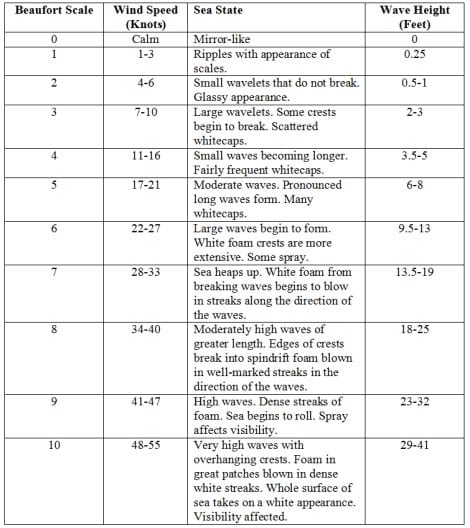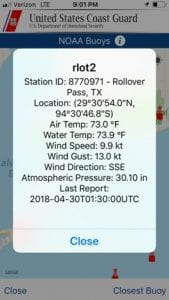 By Bob Currie, Vessel Examiner
By Bob Currie, Vessel Examiner
United States Coast Guard Auxiliary Flotilla 081-06-08
One of the greatest hazards to boaters is when they operate in heavy weather conditions. The waves, seas and wind can present the greatest challenges to seamanship and greatly affect survivability whenever there is an accident. The greatest dangers from heavy weather are that the boat will swamp, capsize, or sink. In any case, the boat occupants will need to be rescued. A boater’s chances of getting home safely depend on knowing when not to go out, knowing when to come in before the weather gets too bad when the weather changes, and knowing when to call for help when the situation becomes dangerous. This column will discuss the wind and how it affects the seas, thunderstorms, and lightning.
Flotilla 081-06-08 is based at Coast Guard Station Galveston. The Coast Guard Auxiliary is the uniformed civilian component of the US Coast Guard and supports the Coast Guard in nearly all mission areas. The Auxiliary was created by Congress in 1939. For more information, please visit www.cgaux.org.
Afternoon Wind Increases
Members of the boating public often get underway in the calm waters of the cool early morning. By afternoon, when they try to get home, the bay or ocean is so choppy that they may find themselves in need of assistance. The wind changes so drastically because the sun warms the earth. The land warms faster than the surface of the water and radiates heat to the overlying air, warming it. This warm air rises, reducing the atmospheric pressure in that area. The air offshore over the ocean is cool, and cool air is dense and heavy. The cool air from offshore flows inland in an attempt to equalize the pressure differential caused by the rising warm air. This flow produces wind, known as sea breeze. After sunset, the inland area cools more quickly than the water, and the wind diminishes.
Sea breezes typically reach their highest speeds during the period of maximum heating (i.e., during mid-afternoon). In some areas a land breeze can be established late at night or early in the morning. For this breeze to occur, the sea surface temperature must be higher than the air temperature over land, along with weak winds prior to the breeze.
Wind Direction
Wind direction is the compass direction from which the wind blows. For instance, a northwest wind blows out of the northwest towards the southeast. This is an important distinction because this is the scheme used by weather services in reporting wind direction.
Beaufort Wind Scale
The Beaufort Wind Scale numbers define a particular state of wind and wave. The scale allows mariners to estimate the wind speed based on the sea state.

The Beaufort scale has 18 categories, but for boat operating purposes, here the scale is limited to 10. Knowledge of this scale should also help you decide when it is time to head for port when the wind change affects the seas to the point that it could be difficult making the return trip. Keep in mind that fighting your way back in against heavier waves than when you went out will greatly increase your fuel consumption. Remember the rule of thumb: 1/3 of your fuel to get out, 2/3 to get back in. Know which of the categories puts your vessel in distress, and make that call to the Coast Guard when you first realize that you are in distress. If you are still able to make headway, report your heading and changes in position regularly when communicating with the Coast Guard Watchstander.
Thunderstorms
A thunderstorm is a violent, short-lived weather disturbance that is almost always associated with lightning, thunder, dense clouds, heavy rain or hail, and strong, gusty winds. Thunderstorms arise when layers of warm, moist air rise in a large, swift updraft to cooler regions of the atmosphere. Thunderstorms are dangerous not only because of lightning, but also because of the strong winds and the rough, confused seas that accompany them. On cloudy days, the prudent boater keeps an eye to the sky in order to have early warning when a thunderstorm develops. Try not to let a thunderstorm cut you off from your route to port. Head in before you get caught.
Lightning
Lightning is a potentially life-threatening phenomenon associated with some storms. Not all storms are thunderstorms, but all thunderstorms have lightning. Lightning occurs when opposite electrical charges within a thundercloud, or between a cloud and the earth, attract. It is actually a rapid equalization of the large static charges built up by air motion within the clouds. Lightning is very unpredictable and has immense power. A lightning “bolt” usually strikes the highest object on the boat, generally the mast or radio antenna. A mast with a full grounding harness affords excellent protection. In addition to using the radar to find the range of a thunderstorm, the boat’s distance from a thunderstorm can be estimated by knowing it takes about five seconds for the sound of thunder to travel each mile.
Waterspouts
A waterspout is a rotating column of air, usually pendant from a cumulus or cumulonimbus cloud, that forms over water and whose circulation extends to the surface. There are two types of waterspouts:
1. Violent convective storms over land moving seaward (tornadoes)
2. Storms formed over sea with fair or foul weather (more common than tornadoes).
Waterspouts develop as a funnel-shaped cloud and when fully developed extend from the water’s surface to the base of a cumulus cloud. The water in a waterspout is mostly confined to its lower portion. The air in waterspouts may rotate clockwise or counterclockwise, depending on the manner of formation. Waterspouts vary in diameter, height, strength and duration, and are found most frequently in tropical regions, but are not uncommon in higher latitudes. They are not always harmless, and, depending on size, can be a great source of danger to boaters.
Tornadoes
Scientists are beginning to realize that there is a direct correlation between lightning and tornadoes. While lightning is certainly a predictor of tornadoes, some scientists think that lightning may actually play a part in creating tornadoes. The type of lightning associated with tornadoes is in-cloud lightning, that is, the flashes that occur within a cloud that never make it to the ground. As a storm builds and more ice particles collide in a cloud, the rate of lightning flashes increases. This increase is often tied to a future growth in a storm’s intensity.
This new information gives us even more reason to be on the lookout for thunderstorms. If you are caught in a lightning strike area, head for shore or the nearest shelter. While underway, stay low in the boat, and try to stay dry. Avoid touching metal such as the throttle and metal steering wheels. Avoid contact with the radio. If lightning strikes, expect the compass to be inaccurate and onboard electronics to suffer extensive damage.
Obtaining Weather Information
Listening to either a news media broadcast meteorologist or NOAA Weather Radio, coupled with local knowledge, should make everyone informed weather-wise. Your VHF/FM marine radio has the ability to scan the weather channels. It is always best to include the weather channels when using your marine radio, but remember- it is not automatic.  You must selectively scan the weather channels along with the marine channels. Most people by now know that I am a big fan of the Coast Guard app for smart phones.
You must selectively scan the weather channels along with the marine channels. Most people by now know that I am a big fan of the Coast Guard app for smart phones.
One source of weather information is the NOAA weather buoys. The Coast Guard App has an icon for locating your proximity to the various weather buoys. By clicking on a buoy, you can obtain the weather at that particular buoy. You can use this knowledge to predict changes in weather based on the reported wind direction, intensity, and your distance from that particular buoy.
For more information on boating safety, please visit the Official Website of the U.S. Coast Guard’s Boating Safety Division at www.uscgboating.org. Questions about the US Coast Guard Auxiliary or our free Vessel Safety Check program may be directed to me at [email protected]. I am available to perform free Vessel Safety Checks, and I will come to your location to perform them. SAFE BOATING!
[4-30-2018]

 Posted in
Posted in 























